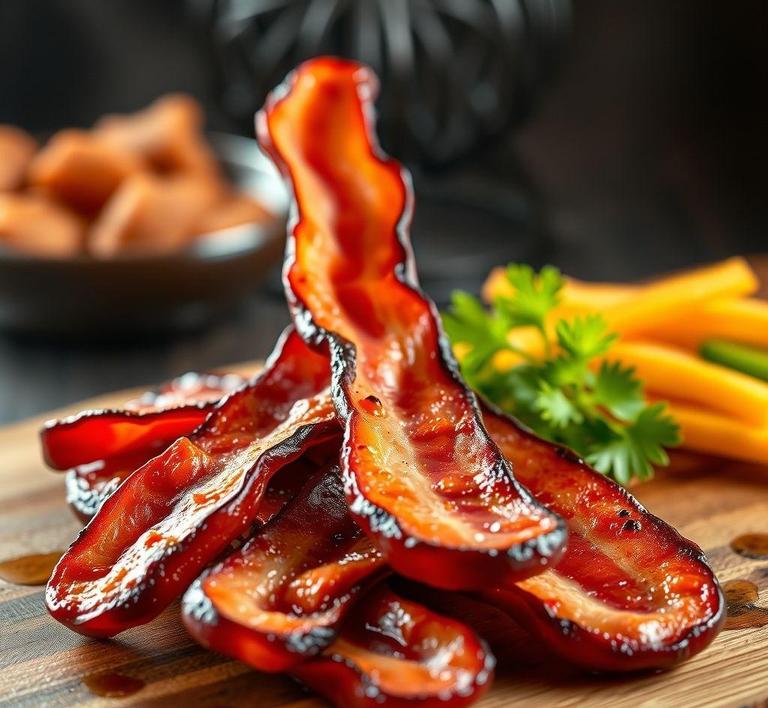So, you’ve cooked up a big batch of bacon and ended up with more than you can eat in one sitting-what do you do with the leftovers? If you’re wondering whether it’s safe to refreeze cooked bacon, the answer is yes, but with a few important guidelines! Refreezing cooked bacon is a great way to save it for later, but you’ll want to make sure you store it properly to maintain its flavor and texture. In this guide, we’ll walk you through the steps, tips, and best practices to ensure your bacon stays crispy and delicious even after it’s been frozen and reheated. Let’s dive in!
Can You Refreeze Cooked Bacon?

When it comes to cooked bacon, the simple yet vital question arises: Can you refreeze cooked bacon? In short, yes, it is technically possible to refreeze cooked bacon, but with some important considerations. Bacon, whether cooked or uncooked, is a type of meat that undergoes specific processes when frozen or thawed. These processes can affect both the flavor and texture of the bacon, especially when it’s refrozen.
Cooked bacon can be refrozen, but its quality might not be as high as when it was first cooked. The reason for this stems from the way bacon is prepared and processed. Initially, bacon is typically cured and smoked, which already involves several steps that impact its texture and moisture content. Freezing cooked bacon doesn’t affect its safety per se, but it does alter the delicate balance of fats and proteins, which can lead to changes in its texture once reheated. For many, this is the deciding factor in whether they will refreeze cooked bacon or not.
When bacon is frozen, the moisture inside the fat cells turns into ice crystals. As the bacon thaws, these ice crystals can break down the cell structure, releasing moisture and making the bacon soggy. When bacon is refrozen, it undergoes this process again, but with a greater likelihood of becoming limp, rubbery, or dry when reheated.
How To Refreeze Cooked Bacon?
Refreezing cooked bacon requires a bit of care to maintain the best possible quality. Here are the key steps you should follow to do it correctly:
1. Cool The Bacon Quickly
The first crucial step is to allow the cooked bacon to cool to room temperature. Never leave cooked bacon out for more than two hours (or one hour if the ambient temperature is 90°F or higher) to avoid the growth of harmful bacteria. However, you shouldn’t leave it sitting around too long, as allowing bacon to cool for an extended period can cause it to absorb moisture from the air, which will make it soggier upon reheating.
2. Pat It Dry
Once the bacon has cooled, use a paper towel to blot away any excess grease or moisture. This step is important, as the presence of extra moisture can cause ice crystals to form inside the bacon during the freezing process, which will result in a mushy texture once thawed and reheated.
3. Wrap It Properly
The key to successful refreezing is ensuring that the bacon is wrapped tightly to prevent freezer burn. You can use freezer-safe plastic wrap or aluminum foil to wrap the bacon in individual portions. For added protection, place the wrapped bacon into a freezer bag or an airtight container to create a sealed barrier against air and moisture.
4. Label And Date
It’s always a good idea to label the package with the date the bacon was cooked. Bacon that’s been refrozen is safe for up to one to two months in the freezer, but for the best quality, it’s recommended to consume it within the first month.
5. Thaw Safely
When you’re ready to use the bacon, thaw it safely by placing it in the refrigerator overnight. Avoid thawing it at room temperature, as this can cause bacterial growth and make the bacon unsafe to eat. If you’re in a hurry, you can also microwave it or thaw it using the defrost setting.
Quality Impact
Refreezing cooked bacon can have a significant impact on its texture and taste. Several factors influence how well the bacon retains its quality:
1. Texture
Bacon is prized for its crispiness, and unfortunately, freezing and refreezing it can cause this crispy texture to suffer. Freezing changes the structure of the fat in the bacon, causing it to lose its firmness and become limp and chewy once reheated. The water in the bacon turns into ice crystals when frozen, and upon thawing, these crystals can rupture cell walls, releasing moisture and leading to a soggy or rubbery texture.
However, this effect can be mitigated somewhat by cooking the bacon to a crisp before freezing. If you make sure to cook it to the desired crispiness before freezing, the bacon might retain some of that crunch once reheated, although it will never be exactly the same as freshly cooked bacon.
2. Flavor
While bacon will retain its basic flavor after freezing and refreezing, some people find that the flavors can become less distinct. The fat in the bacon, which is responsible for much of its flavor, can break down during the freezing process, leading to a less vibrant taste. Additionally, because bacon is often seasoned, freezing can dull these spices, making the bacon taste somewhat blander than it did when it was fresh.
3. Moisture Loss
Bacon tends to lose moisture in the freezing process, and each cycle of freezing and thawing exacerbates this issue. If the bacon is not wrapped well enough, it might develop freezer burn, which further dries out the bacon and imparts an off taste. This can leave you with bacon that tastes more like a dry, overcooked snack than the savory, crispy strips you originally enjoyed.
4. Fat Content
The fat in bacon is both a blessing and a curse when it comes to freezing. While the fat provides flavor and moisture, it is also the component most likely to degrade in quality with multiple freezing and thawing cycles. If you’re freezing cooked bacon, be aware that the rendered fat may crystallize and solidify in an unpleasant way, making the bacon feel greasy and less enjoyable.
While it is technically safe to refreeze cooked bacon, it’s not without its downsides. The quality of the bacon may suffer with each cycle of freezing and thawing. The texture tends to become less crispy and can turn rubbery or soggy, while the flavor may lose some of its intensity. However, if you’re okay with a slightly diminished quality and follow the proper freezing and thawing techniques, refreezing cooked bacon can be a convenient way to avoid food waste.
If you want to preserve the best quality, it’s a good idea to only freeze cooked bacon once, and make sure you follow all the necessary steps to minimize the impact on texture and flavor. For those who don’t mind the change in quality, refreezing cooked bacon can still be a time-saving option to have cooked bacon on hand for future meals. Ultimately, it all comes down to balancing convenience with the desire for the best bacon experience possible.
Is It Safe To Refreeze Cooked Bacon?
Refreezing cooked bacon is a topic that often stirs confusion in the kitchen. The safety of doing so is primarily governed by how the bacon was initially handled, cooked, and stored. The general guideline for refreezing cooked bacon is that, under the right conditions, it can be refrozen, but there are a few important factors to consider.
When bacon is cooked and then frozen, its quality can suffer upon being refrozen. The texture of bacon after being cooked, frozen, and refrozen may become limp and lose its crispiness. The main concern with refreezing cooked bacon, however, is the potential for bacterial growth. After cooked bacon has been thawed and left at room temperature for more than two hours, bacteria can begin to multiply, which may increase the risk of foodborne illnesses if it’s refrozen and reheated.
For cooked bacon to be safely refrozen, it must be properly handled at each stage. If the bacon has been left at room temperature for an extended period of time or thawed multiple times, refreezing is not advised. However, if the bacon has been refrigerated for no longer than four days and is still in a safe, cold environment, it’s perfectly fine to refreeze it as long as it’s done in a timely manner.
Signs That Cooked Bacon Should Not Be Refrozen
While cooked bacon can technically be refrozen if it’s been handled correctly, certain signs will tell you whether it’s too risky or unsafe to do so. Here are the key indicators that your bacon is past its prime:
- Spoiled or Off Odor: Bacon that has gone bad will have a sour, rancid, or off-putting smell. If you notice a distinct change in aroma, it’s a clear sign that bacteria or spoilage is at play. Trust your senses – if the bacon smells bad, it’s not safe to refreeze.
- Discoloration or Sliminess: Cooked bacon should maintain its golden-brown color after it’s been cooked and frozen. If you notice a dull, grayish hue or slimy texture on the bacon after thawing, this is a red flag. Bacon that has developed a slimy surface is likely contaminated with bacteria, and refreezing will not make it safe.
- Mold or Fungal Growth: Moldy bacon is a definite no-go. Mold spores are a visible sign of bacterial contamination and should never be ignored. Any appearance of fuzziness, whether white, green, or black, indicates the bacon should be discarded immediately.
- Extended Time Out of the Freezer: If the bacon has been left out at room temperature for more than two hours, it is not safe to refreeze. Bacteria thrive at temperatures between 40°F (4°C) and 140°F (60°C), which means if cooked bacon has spent too long in this “danger zone”, it could pose health risks.
- Off Taste: A weird, sour, or rancid taste when you eat it (even if it’s been reheated) is a strong sign that bacteria have affected the bacon. If it tastes off, don’t risk refreezing.
Common Refreezing Mistakes
Even with the best intentions, there are a few common mistakes people make when it comes to refreezing cooked bacon, which can lead to compromised safety or quality:
- Not Cooling the Bacon Properly Before Freezing: One of the most crucial steps in freezing any food is ensuring it cools properly first. If you freeze cooked bacon while it’s still warm or hot, you risk introducing moisture into the package, which will lead to freezer burn or soggy bacon when it’s reheated. Always allow the bacon to cool completely before freezing, ideally within 1-2 hours after cooking.
- Refreezing Without Wrapping It Well: Bacon is prone to absorbing flavors and odors from other foods in the freezer, so it’s important to package it tightly. If bacon isn’t wrapped well in an airtight container or sealed plastic bag, it can suffer from freezer burn. This will alter the texture, flavor, and overall enjoyment of your bacon when reheated.
- Thawing and Refreezing Multiple Times: One of the biggest mistakes is repeatedly thawing and refreezing bacon. Every time food goes through the freeze-thaw cycle, it opens up the potential for bacterial growth, affecting both the safety and taste of the bacon. Try to only thaw the bacon once and use it up within a short time frame.
- Not Labeling and Dating the Bacon: It’s easy to forget when you froze a batch of cooked bacon, especially if it’s tucked into the back of the freezer. Bacon that’s been frozen for too long (generally over six months) will lose flavor and texture, and it may not be safe to eat. Be sure to label and date all frozen food so you can track how long it’s been stored.
- Freezing Bacon After It’s Been Left Out for Too Long: This is a mistake people often make, thinking that freezing bacon will “stop” spoilage. However, bacteria multiply rapidly when food is left at room temperature for extended periods. If bacon has been sitting out too long, it should be discarded, not refrozen.
Tips And Tricks
If you’re determined to refreeze your cooked bacon while maintaining both its safety and quality, here are a few useful tips and tricks:
- Use Freezer-Friendly Packaging: Wrap your cooked bacon in parchment paper or plastic wrap, and then place it inside a freezer-safe bag or airtight container. This double layer will protect the bacon from freezer burn and maintain its flavor and texture.
- Portion the Bacon Before Freezing: If you know you won’t be using a whole batch of bacon at once, portion out small amounts before freezing. This makes it easier to thaw only what you need, preventing repeated thawing and refreezing.
- Flash Freeze Before Storing: For added protection against freezer burn, flash freeze the cooked bacon before sealing it in a bag. Lay the cooked bacon strips out on a baking sheet in a single layer, freeze them for about 1-2 hours, and then transfer them to an airtight container. This method prevents the strips from sticking together and keeps them fresher for longer.
- Reheat with Care: When you’re ready to enjoy your frozen bacon, avoid reheating it directly from the freezer. Thaw it overnight in the fridge or use the defrost function on your microwave. Then, reheat it slowly in the oven or on a skillet to maintain the best texture.
- Use Bacon Within 3-6 Months: Bacon, like any other food, will maintain the best flavor and texture if used within a reasonable time frame. Use frozen cooked bacon within 3 to 6 months to get the most out of it. Beyond this time, its quality will degrade significantly.
Conclusion
Refreezing cooked bacon is not inherently dangerous, but it requires careful handling to ensure both safety and quality. By following proper food safety practices, like cooling the bacon fully, wrapping it tightly, and avoiding multiple cycles of freezing and thawing, you can safely enjoy bacon even after it’s been frozen. However, be mindful of the signs that indicate the bacon has spoiled, and avoid refreezing if the bacon shows any indication of bacteria or mold growth. If handled correctly, you can keep bacon stored for longer periods, preventing waste and allowing you to enjoy that crispy, salty goodness on demand. Just remember to freeze with care, and you’ll get the most out of your cooked bacon.


